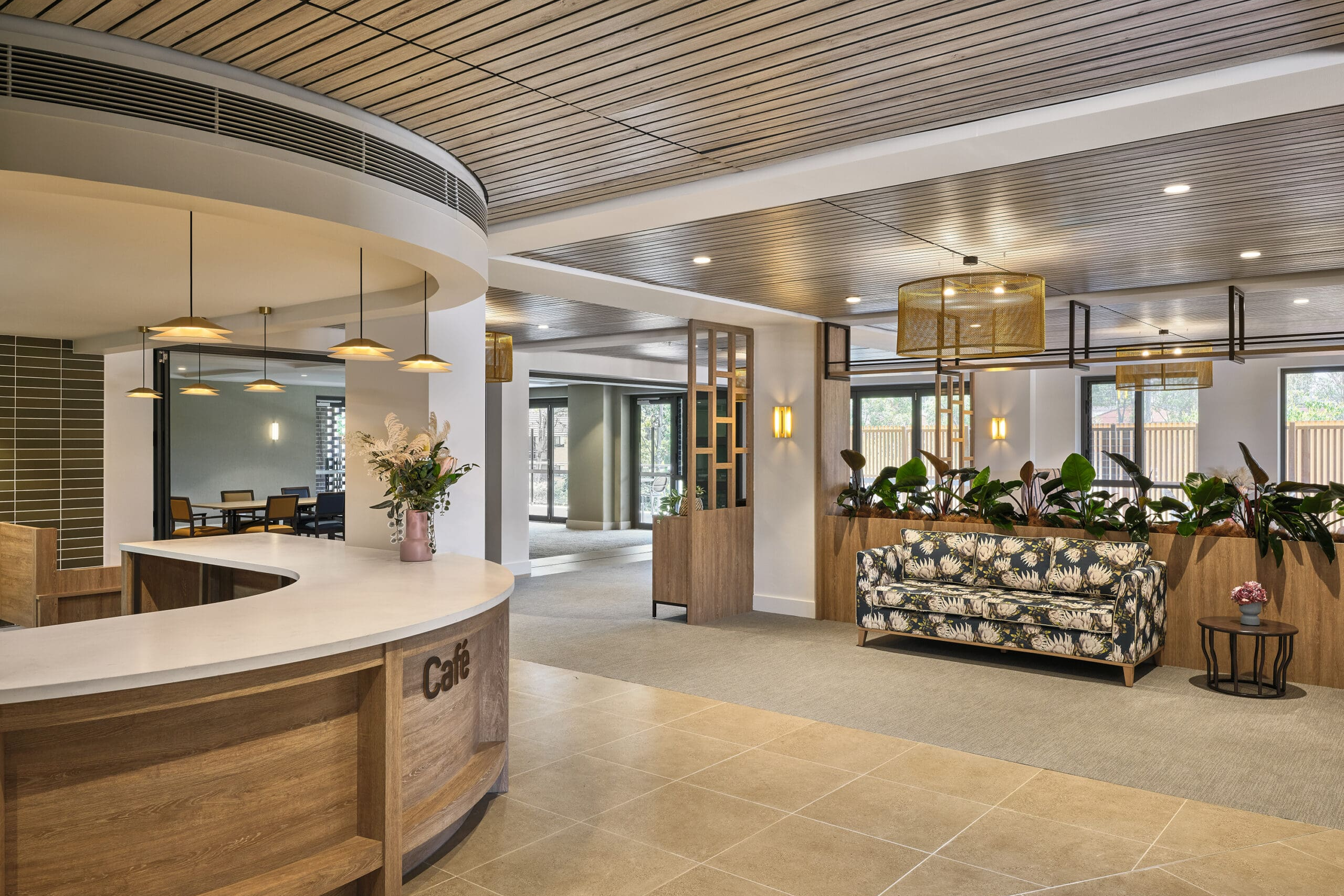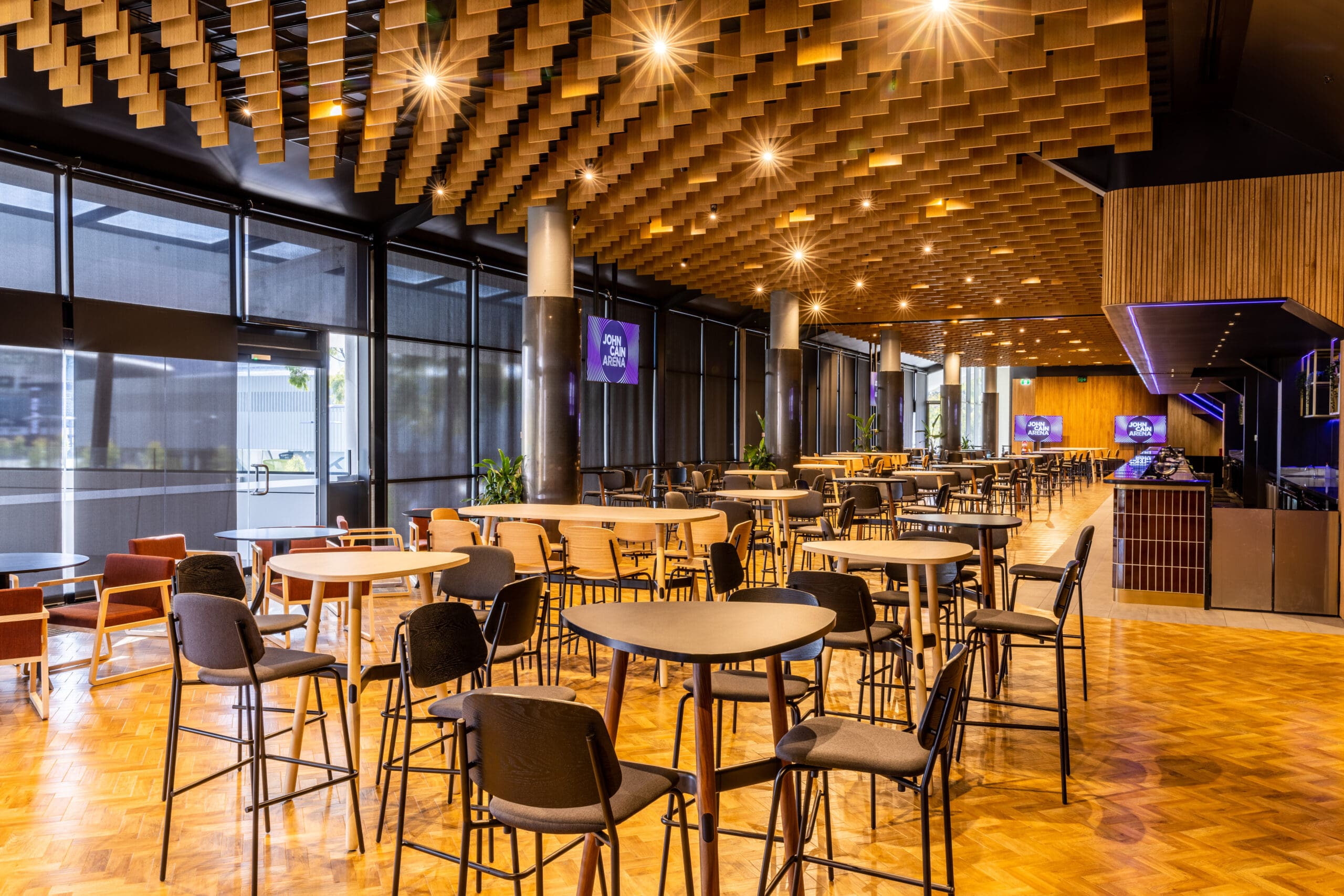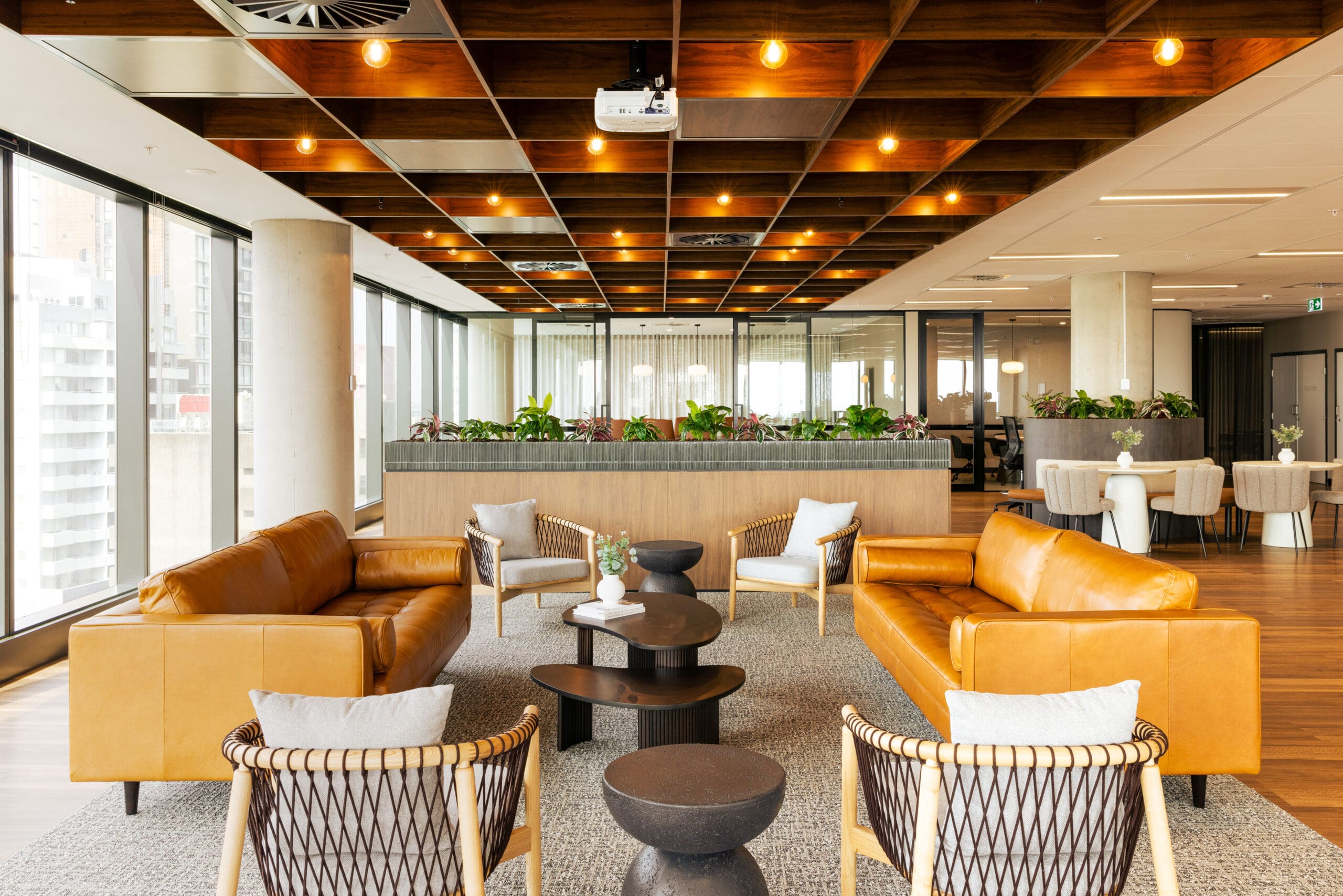It might seem funny to compare schools and restaurants in this context, but when it comes to choosing between fabric or timber panels for aesthetics, durability, and acoustics, they both have many similarities, especially when comparing their critical areas: classrooms and restaurant dining areas.
The clientele is also similar, in that they both tend to be noisy, somewhat careless, with even the possibility of vandalism.
In both, the role of acoustics and durability play critical roles for the above reasons. Poor acoustics in a classroom leads to student inattention and proven inferior performance. Poor acoustics in a restaurant leads to poor reviews and a low rate of return.
This article will compare fabric panels, solid timber panels and acoustic timber panels (perforated, slotted, or slatted) across several characteristics.
The characteristics we’ll evaluate them by will be in terms of durability, acoustics, aesthetics, costs, and fire compliance.
What makes selection tricky is that no one panel will give you the best solution in all areas. However, if you know what each panel type has to offer, it will be easier to see which one offers the best combination for your project situation.
Durability
The discussion around this characteristic also applies to entrance areas, lobbies, and passages.
For straight out durability and good wear and tear, solid timber and most acoustic timber panels are always your best choice.
If you need timber acoustic panels and durability, go for 7mm or smaller holes, as this prevents persons poking items through slots or between slats and/ or breaking the acoustic fabric at the back of the panel.
Fabric panels score worst here, due to the inherent fragility of their surface, so if you do need to use them, make sure you keep them above dado rail height and away from sitting areas.
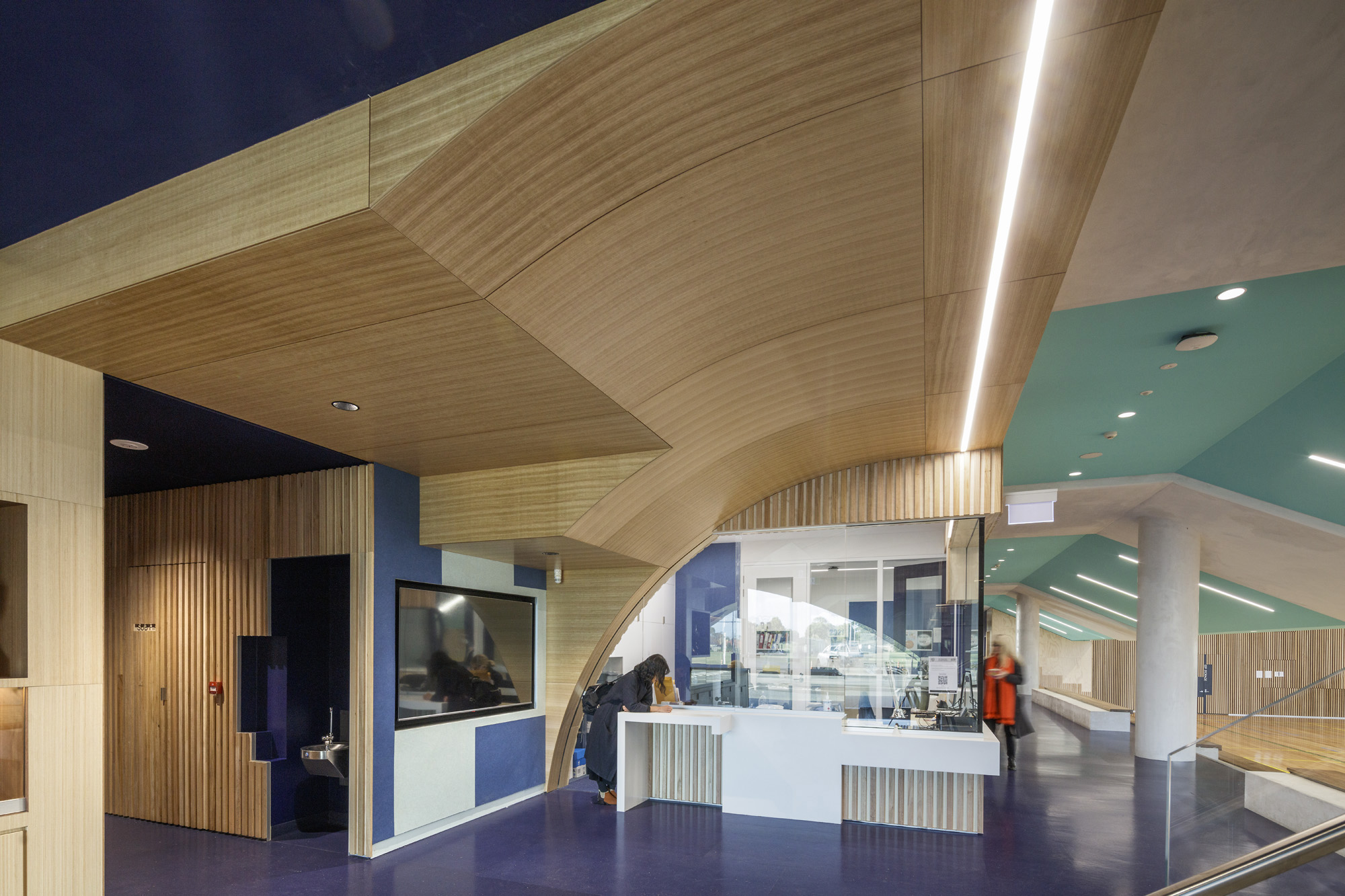
Penleigh & Essendon Grammar School Gym Foyer
Acoustics
How critical your acoustic panel requirements will depend on the use of the space and on other finishes in the area. For example, if you have a lot of soft finishes like carpet and upholstery, you want some acoustic timber surfaces or perforated metal or plasterboard to achieve satisfactory speech intelligibility. These harder, resonant acoustic materials will absorb the lower frequencies of speech.
If you only have soft finishes, which absorb the higher frequencies of speech, you will create distortion of the spoken word, making it hard for students to hear the teacher, or for a diner to hear a waiter. Each space needs to balance the absorption of lower and higher frequencies, as too much absorption of one will affect overall speech intelligibility, making conversation difficult.
Unfortunately, many acoustic consultants do not take this into account for “non-performance” areas. They then proceed to request a “0.7 NRC”, “0.8 NRC” or similar. This is not helpful or safe, as your average absorption might be fine, but it is still hard to hear persons because of the imbalance between high and low frequency absorption.
Remember, every teacher and every waiter are really doing their own performance in a way, even if they are not performing music!
If your area contains mainly hard surfaces, like glass, metal, tile, and the like, you will still need acoustic timber panels or plasterboard for low frequency absorption. You can also use fabric panels or mineral fibre tiles for higher frequency absorption. Humans are good high frequency absorbers, so generally it is more important to ensure sufficient low frequency absorption than high frequency absorption.
Clients may be concerned about the overall level of noise in the area and may want plenty of acoustic absorption. Just make sure you have balanced hard and soft materials though, or you will still have persons struggling to make themselves heard.
If you need to achieve a very high level of acoustic absorption across the frequency spectrum, slatted acoustic timber panels are your best bet, being able to achieve up to 1.0 NRC, which means excellent absorption throughout the frequency spectrum.
Note solid timber panels do not offer any acoustic absorption at all, so use these only if you have plenty of other absorptive materials, or the acoustics does not matter, like a corridor.
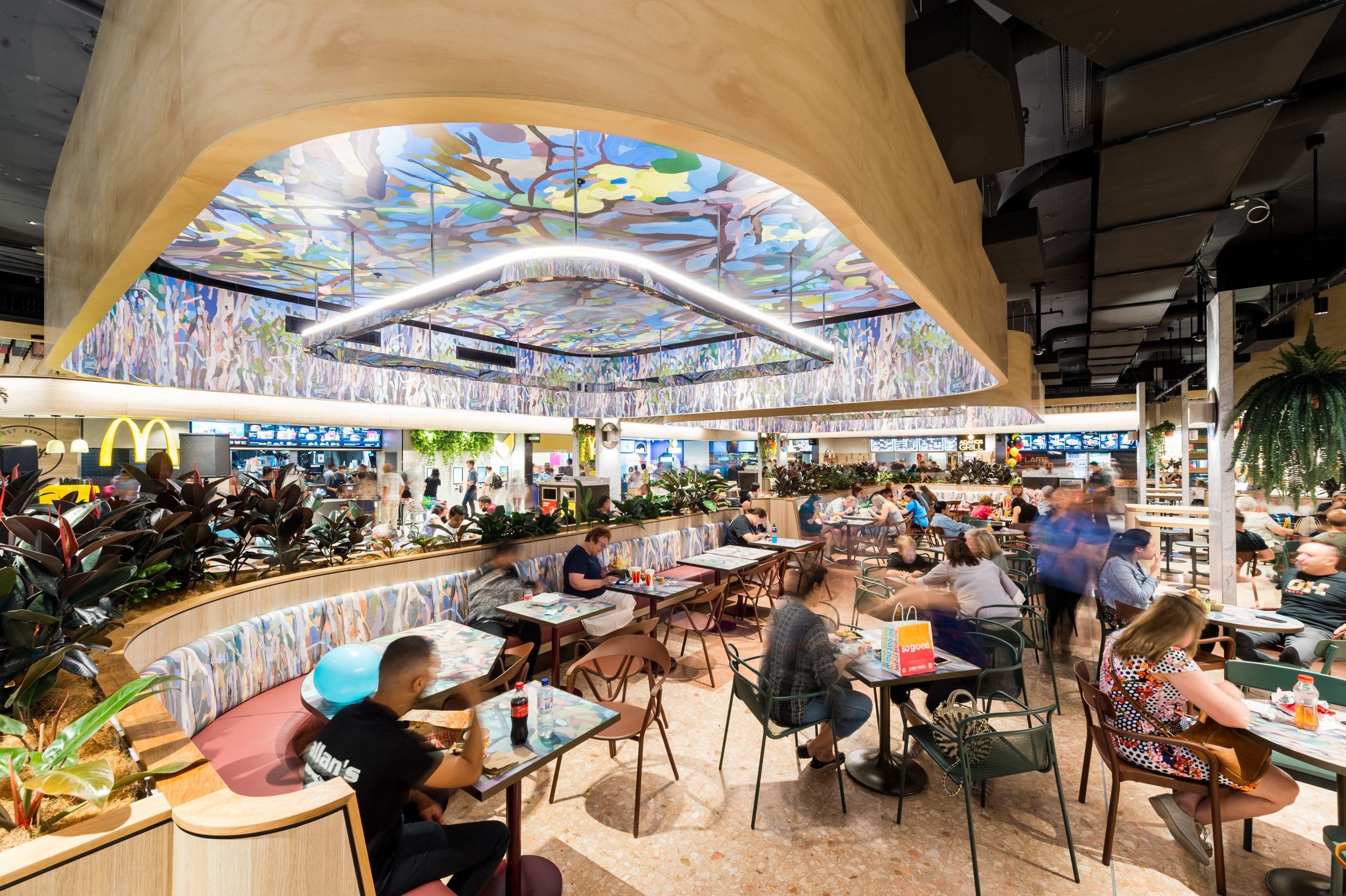
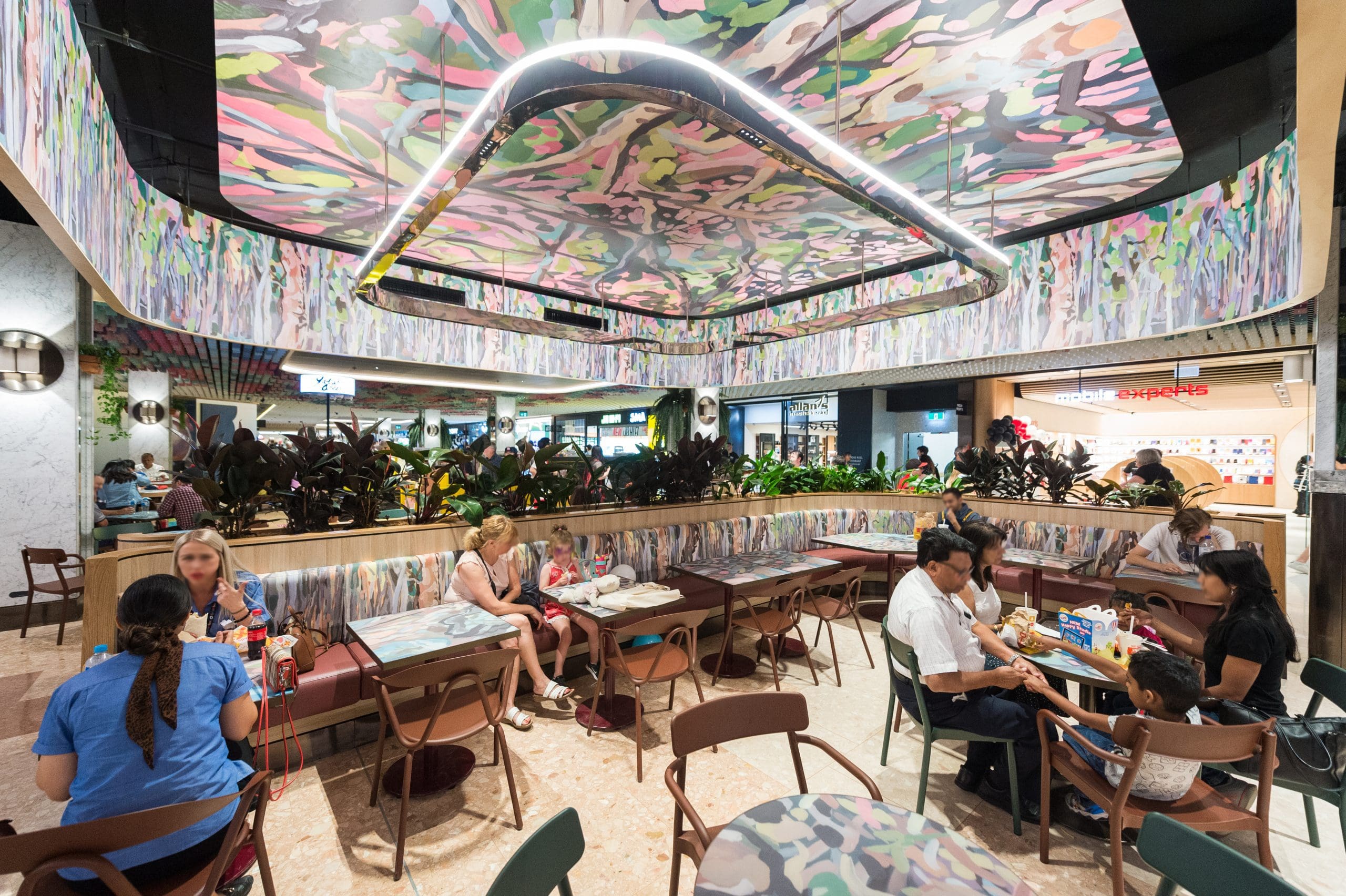
Castle Towers Food Court Refurbishment
Aesthetics
The décor or look of any area, when one first walks into a room and gets that initial impression, is always a subject close to an architect’s heart. Remember, when a photograph is taken of the area (which happens all too often these days), the architectural appeal of the area is what’s going to be noticed, and not any of the other characteristics we cover in this article.
Fabric panels are the least impressionable unless you can use the shaped type and/ or mix colours to get some art into their placement.
Solid timber panels are a bit more versatile when it comes to design, and acoustic timber panels very much more so. Solid timber panels can have special shapes and sizes, can be positioned at angles to the wall or ceiling to create a 3D effect, or be decorated with grooves.
Under the category of acoustic timber panels, you can have perforated, slotted, or slatted panels. These are available in custom configurations to suit your ideal design, including perforations showing images, and slats running in custom patterns like 45 degrees to the usual plane.
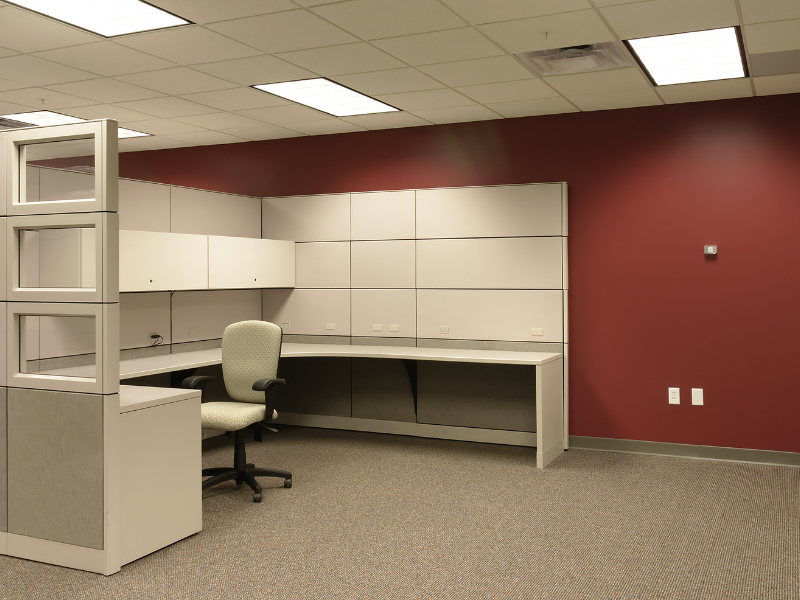
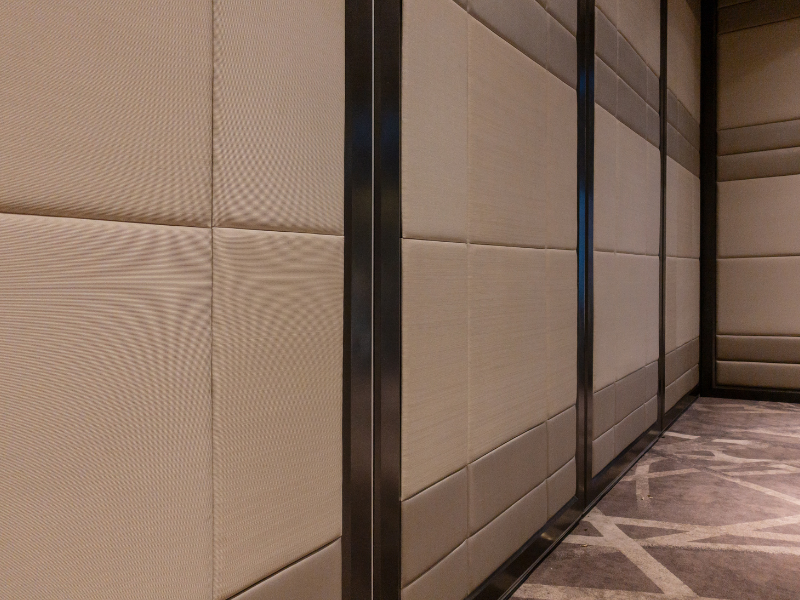
Generic Fabric panels
Costs
Costs are generally proportionate to how impressive a panel looks on the wall or ceiling.
Your cheapest options are fabric panels and simple solid timber panels.
Next come your more customised solid timber panels and your simple acoustic timber panels, like those with standard slots or perforation holes in them.
Most expensive of all are your customised acoustic timber panels, where finish selected can also make a big difference.
If a client is concerned about costs and wants to reduce the acoustics in an area, remind them that acoustic problems don’t go away with budget cuts, and most people that delete acoustic panels end up regretting it or installing them later.
Fire Compliance
The rules around fire compliance for internal linings changed in May 2019 with the introduction of the updated NCC testing regime. The BCA now calls for full room burn tests (ISO 9705) for all types of acoustic panelling. The result is typically a Fire Group 1, 2 or 3, with a Fire Group 4 result meaning it can’t be used in commercial buildings. This is a very demanding test, costing typically $20,000 each including installation, so many suppliers do not have it, or do not have it for all their products.
However, good suppliers do ensure they have the correct certifications, so make sure you deal with a reputable supplier and request the compliance certification up front, so you don’t have any embarrassment later.
A few tips to help you in this complex area:
| Restaurants
Restaurants are Class 6 buildings or spaces as they are a retail environment. Generally, Fire Group 3 is allowed which means there are no restrictions on what material you use. However, there are several exceptions to this: Low ceilings – if your space has a floor dimension that is more than 5 times your ceiling height, then you need to have Fire Group 2 on your ceiling. For example, if you have a floor dimension of 15 metres, and your ceiling height is 2.5 metres, your ratio is 15/ 2.5 = 6, so you will require a Fire Group 2 ceiling. Enclosed corridor, hallway or the like that is required to exit the building – if you have a space or spaces like this, they need to have Fire Group 2 on both walls and ceilings. Public assembly space – if you are holding performances in your restaurant, your performance space may be deemed by the building surveyor to be a public assembly space which is a Class 9b building. If he also deems it to be an Auditorium, you will need to have Fire Group 2 on both walls and ceilings. In this case, adjacent enclosed corridors as above will need to be Fire Group 1 unless they are sprinklered. Internal lining to the external walls of buildings of two stories or more – the BCA requires this classification to be entirely non-combustible. This means you either have to use something non-decorative, like plasterboard, or a metal product, like Supawood’s aluminium range which is available in a realistic timber woodgrain. |
| Schools
Most fire requirements of schools are the same as restaurants but there are some differences as follows: Enclosed corridor, hallway or the like that is required to exit the building – if you have a space or spaces like this, they need to have Fire Group 2 on both walls and ceilings. Public assembly space – if you are hiring a hall out to the public for weddings, for example, your performance space may be deemed by the building surveyor to be a public assembly space which is a Class 9b building. If he also deems it to be an Auditorium, you will need to have Fire Group 2 on both walls and ceilings. In this case, adjacent enclosed corridors as above will need to be Fire Group 1 unless they are sprinklered. Classrooms – these must have Fire Group 2 ceilings. Fire-isolated exits and stairwells – these must have Fire Group 1 walls and ceilings. Internal lining to the external walls of buildings of two stories or more – the BCA requires this classification to be entirely non-combustible. This means you either have to use something non-decorative, like plasterboard, or a metal product, like Supawood’s aluminium range which is available in a realistic timber woodgrain. |
Last of all, remember that generic versions of the above options are not available in Fire Group 1,2 or 3. If you require fire certifications, then you need to use a proprietary product from a reputable supplier.
Note slotted panels are not available in Fire Group 1, only Fire Group 2. However, perforated or slatted acoustic timber panels, solid timber panels, and fabric panels are all available in Fire Group 1. Note the method of installation affects the fire rating of a panel, so be aware of what fixing system you are specifying.
We will complete our article with a table showing the main advantages and disadvantages of each panel type as compared across these characteristics.
| Fabric panels | Acoustic timber panels | Solid timber panels | ||||
| Advantages | Disadvantages | Advantages | Disadvantages | Advantages | Disadvantages | |
| Durability | Not durable nor easy to keep clean | Very durable and easy to clean | Openings or holes larger than 7mm can allow for vandalism | Very durable and easy to clean | ||
| Acoustics | Good higher frequency absorption | Poor low frequency absorption | Good low frequency absorption with overall NRC possible of up to 1.0 | If positioned at angles, will deflect sound and make acoustic panels more effective | No acoustic absorption | |
| Aesthetics | Can mix colours or have special shapes | Limited design options due to limited customisation possiblities | Unlimited scope for design | Unlimited scope for design | ||
| Costs | Can be used in large quantities | Larger quantities require a good budget | Can be used in large quantities | |||
| Fire Compliance | Available in Fire Group 1 | Available in Fire Group 1 and non-combustible versions | Available in Fire Group 1 and non-combustible versions | |||
Choosing materials for a project is becoming increasingly demanding and complicated for architects and interior designers, as suppliers are ever offering more products, and government agencies are ever imposing more restrictions accordingly.
However, we hope this article helps you in your selection process, so that you can choose the best product type for your application and design.
If you would like Supawood’s advice and evaluation for your project, please feel free to contact us here:
Disclaimer: All the information on this website - www.supawood.com.au - is published in good faith and for general information purpose only. Supawood does not make any warranties about the completeness, reliability, and accuracy of this information. Any action you take upon the information you find on this website (Supawood), is strictly at your own risk. Supawood will not be liable for any losses and/or damages in connection with the use of our website.
From our website, you can visit other websites by following hyperlinks to such external sites. While we strive to provide only quality links to useful and ethical websites, we have no control over the content and nature of these sites. These links to other websites do not imply a recommendation for all the content found on these sites. Site owners and content may change without notice and may occur before we have the opportunity to remove a link that may have failed.
Consent: By using our website, you hereby consent to our disclaimer and agree to its terms.

